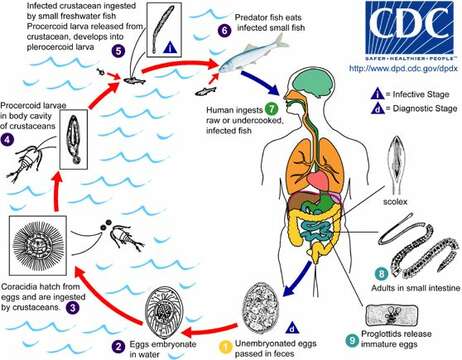Life cycle of the Broad Tapeworm (Diphyllobothrium latum)

Description:
Life cycle of the Broad Tapeworm (Diphyllobothrium latum)
Immature eggs of the Broad Tapeworm (Diphyllobothrium latum) are passed in feces (1) from the definitive host. Under appropriate conditions, the eggs mature (after approximately 18 to 20 days) (2) and yield oncospheres, which develop into a coracidia (3). After ingestion by a suitable freshwater crustacean (the copepod first intermediate host), the coracidia develop into procercoid larvae (4). Following ingestion of the copepod by a suitable second intermediate host, typically minnows and other small freshwater fish, the procercoid larvae are released from the crustacean and migrate into the fish flesh, where they develop into a plerocercoid larva (sparganum) (5). The plerocercoid larvae are the infective stage for humans. Because humans do not generally eat undercooked minnows ans similar freshwater fish, these do not represent an important source of infection. Nevertheless, these small second intermediate hosts can be eaten by larger predator species such as trout, perch, and walleyed pike (6). In this case, the sparganum can migrate to the musculature of the larger predator fish and humans can acquire the disease by eating these later intermediate infected host fish raw or undercooked (7). After ingestion of the infected fish, the plerocercoid develop into immature adults and then into mature adult tapeworms, which will reside in the human host's small intestine. The adults of D. latum attach to the intestinal mucosa by means of the two bilateral grooves (bothria) of the scolex (8). The adult tapeworms can exceed 10 m in length, with more than 3,000 proglottids. Immature eggs are discharged from the proglottids (up to 1,000,000 eggs per day per worm) (9) and are passed in the feces (1). Eggs appear in the feces 5 to 6 weeks after infection. In addition to humans, many other mammals can also serve as definitive hosts for D. latum.
From Centers for Disease Control Parasites and Health website.
Included On The Following Pages:
- Life
- Cellular
- Eukaryota (eukaryotes)
- Opisthokonta (opisthokonts)
- Metazoa (animals)
- Bilateria
- Protostomia (protostomes)
- Spiralia (spiralians)
- Platyhelminthes (flatworms)
- Cestoda (cestodes)
- Diphyllobothriidae
- Dibothriocephalus
- Rhabditophora
- Dibothriocephalus latus
This image is not featured in any collections.
Source Information
- license
- cc-by-nc
- copyright
- Centers for Disease Control/Division of Parasitic Diseases and Malaria
- publisher
- Shapiro, Leo
- photographer
- Centers for Disease Control/Division of Parasitic Diseases and Malaria
- provider
- EOL Rapid Response Team
- original
- original media file
- visit source
- partner site
- EOL staff
- ID


